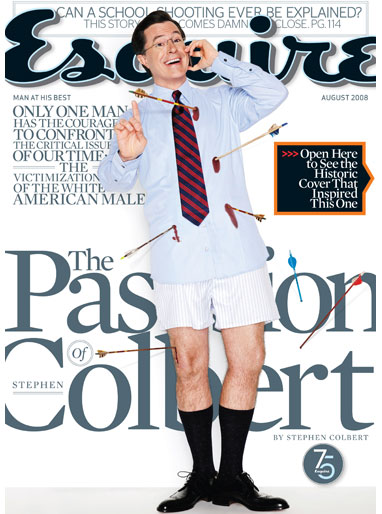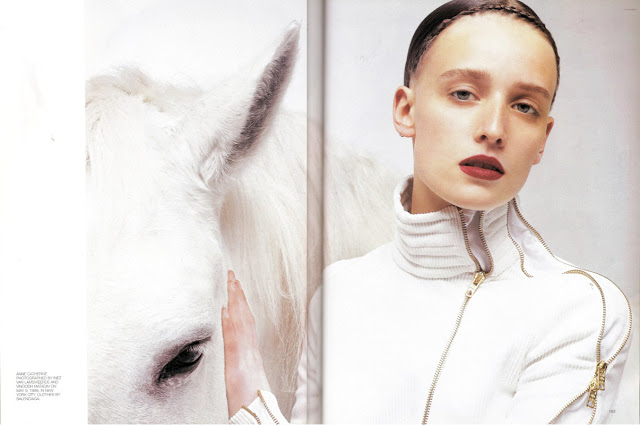“The April 1968 Esquire cover of Muhammad Ali posing as the martyr St. Sebastian was one of the most iconic images of the decade, tying together the incendiary issues of the Vietnam War, race and religion. The image is so powerful that some people of a certain age remember where they were when they saw it for the first time. “
Associated Press
 Muhammad Ali posing as Saint Sebastian, the patron saint of sports
Muhammad Ali posing as Saint Sebastian, the patron saint of sports
SOURCE OF INSPIRATION
 Saint Sebastian, Francesco di Giovanni Botticini, ca. 1446–1497
Saint Sebastian, Francesco di Giovanni Botticini, ca. 1446–1497

“In 1967, Muhammad Ali, the world’s heavyweight champion, refused induction into the Army. He had converted to Islam, and under the tutelage of Eliah Muhammad he became a Black Muslim minister. When Cassius Clay became a Muslim, he had also become a martyr. In 1968, while he was waiting for his appeal to reach the Supreme Court, I wanted to pose as St. Sebastian, modeled after the 15th-century painting by Botticini that hangs in the Metropolitan. I contacted Ali and explained this idea and he agreed to fly to New York to pose. At the studio, I showed him a postcard of the painting to illustrate the stance. He studied it with enormous concentration. Suddenly he blurted out, “Hey George, this cat’s a Christian!” I blurted back, “Holy Moses, you’re right Champ!” I explained to Ali that St. Sebastian was a Roman soldier who survived execution by arrows for converting to Christianity. He was then clubbed to death, and has gone down in history as the definitive martyr. Before we could affix any arrows to Ali, he got on the phone with his religious leader, Eliah Muhammad. Ali explained the painting in excruciating detail. He was concerned about the propriety of using a Christian source for the portrayal of his martyrdom. He finally put me, a non-practicing Greek Orthodox, on the phone. After a lengthy theological discussion Eliah gave me his okay. I exhaled and we shot this portrait of a deified man against the authorities. When I saw the first transparency, I believe my exact words to photographer Carl Fischer were “Jesus Christ, it is a masterpiece” Esquire had a sensational cover, and it was reproduced and sold as protest poster. Three years later the Supreme Court unanimously threw out Ali’s conviction. Allah be praised!”
George Lois
Around that time, Esquire had been featuring controversial covers dreamt up by George Lois, a former ad man. Lois has been widely credited for shaping a generational shift that reflected a turbulent era’s need for change, but he didn’t act alone. For fourteen years, starting in 1963, Carl Fischer consistently photographed the Esquire covers capturing the decade’s revolutionary changes during a time of an unwanted war, a sexual revolution, and a demand for civil rights.



We worked over the telephone. Lois never made layouts, never made drawings for the covers. He just had the idea of what the cover should be and he would call up and say, “We have a story about Ali and the fact that he lost his title. Why don’t we do something with him as Saint Sebastian?” And that’s the way it worked on all the covers. I would work out the problems of how to do it and Lois would sometimes show up at the shoots if they were in New York, which was the case here.
I had the arrows made by a model-maker in New York. I assumed we’d paste them on and that would be the end of it. Unfortunately, when you pasted the arrows on, they hung down. They didn’t stay horizontally as they should. So we made an elaborate device; we put a pole above Ali and hung monofilament lines, little fishing lines, from each arrow up to the pole. You could see the lines, slightly, on the final print, and they were retouched out. But they were hard to see because they were thin and transparent.

Nowadays, we wouldn’t have had that problem; we would’ve put the arrows in [digitally]. But at the time, they had to be pasted on him physically. It was a long, boring process. Ali had to hold the position for an hour.
Carl Fischer
SUCCESORS

Tom Cruise. Radar magazine, September/October 2006
 “Sebastien Moura is St Sebastian” in Refresh. June/July 2007. Photo by Aleksandar Tomovic
“Sebastien Moura is St Sebastian” in Refresh. June/July 2007. Photo by Aleksandar Tomovic
 John Galliano. Esquire magazine 75th anniversary (2009)
John Galliano. Esquire magazine 75th anniversary (2009)

Stephen Colbert. August 2009 issue
 October 2009 issue. Ricky Gervais chose to restage a 1968 cover shot of Ali cover which showed boxer with six arrows piercing in his body
October 2009 issue. Ricky Gervais chose to restage a 1968 cover shot of Ali cover which showed boxer with six arrows piercing in his body
 Esquire UK, 20th anniversary (2011)
Esquire UK, 20th anniversary (2011)
 Harper’s Bazaar, July 1999 issue. Tom Cruise’s cover was the last cover approved by Liz before her death just 3 months prior. All ad revenue went to the Ovarian Cancer Research Fund. Models, photographers, stylists, make-ups artists, etc., donated their time for free. There are no editorials. It is the one issue which features the solidarity of the fashion industry for an icon.
Harper’s Bazaar, July 1999 issue. Tom Cruise’s cover was the last cover approved by Liz before her death just 3 months prior. All ad revenue went to the Ovarian Cancer Research Fund. Models, photographers, stylists, make-ups artists, etc., donated their time for free. There are no editorials. It is the one issue which features the solidarity of the fashion industry for an icon.
 Illustrations by Karl Lagerfeld
Illustrations by Karl Lagerfeld Christy Turlington photographed by Patrick Demarchelier
Christy Turlington photographed by Patrick Demarchelier Guinevere Van Seenus photographed by Craig McDean, clothes by Yohji Yamamoto
Guinevere Van Seenus photographed by Craig McDean, clothes by Yohji Yamamoto Naomi Campbell photographed by David Bailey clothes by Versace
Naomi Campbell photographed by David Bailey clothes by Versace Left: Linda Evangelista illustrated by Mats Gustafsson; Guinevere Van Seenus photographed by Richard Burbridge
Left: Linda Evangelista illustrated by Mats Gustafsson; Guinevere Van Seenus photographed by Richard Burbridge Nikki Uberti photographed by Terry Richardson, clothes by Dolce and Gabbana
Nikki Uberti photographed by Terry Richardson, clothes by Dolce and Gabbana Anne Catherine Lacroix photographed by Inez van Lamsweerde and Vinoodh Matadinanne, clothes by Balenciaga
Anne Catherine Lacroix photographed by Inez van Lamsweerde and Vinoodh Matadinanne, clothes by Balenciaga Erin O’Connor photographed by Patrick Demarchelier., clothes by Calvin Klein
Erin O’Connor photographed by Patrick Demarchelier., clothes by Calvin Klein Natalie Portman photographed by Robert Bromann, clothes by Moschino; Cindy Crawford photographed by Mary Ellen Mark, clothes by Malo; Rita Wilson photographed by Sante D’Orazio; Milla Jovovich photographed by Cliff Watts, clothes by Tommy Hilfiger
Natalie Portman photographed by Robert Bromann, clothes by Moschino; Cindy Crawford photographed by Mary Ellen Mark, clothes by Malo; Rita Wilson photographed by Sante D’Orazio; Milla Jovovich photographed by Cliff Watts, clothes by Tommy Hilfiger














